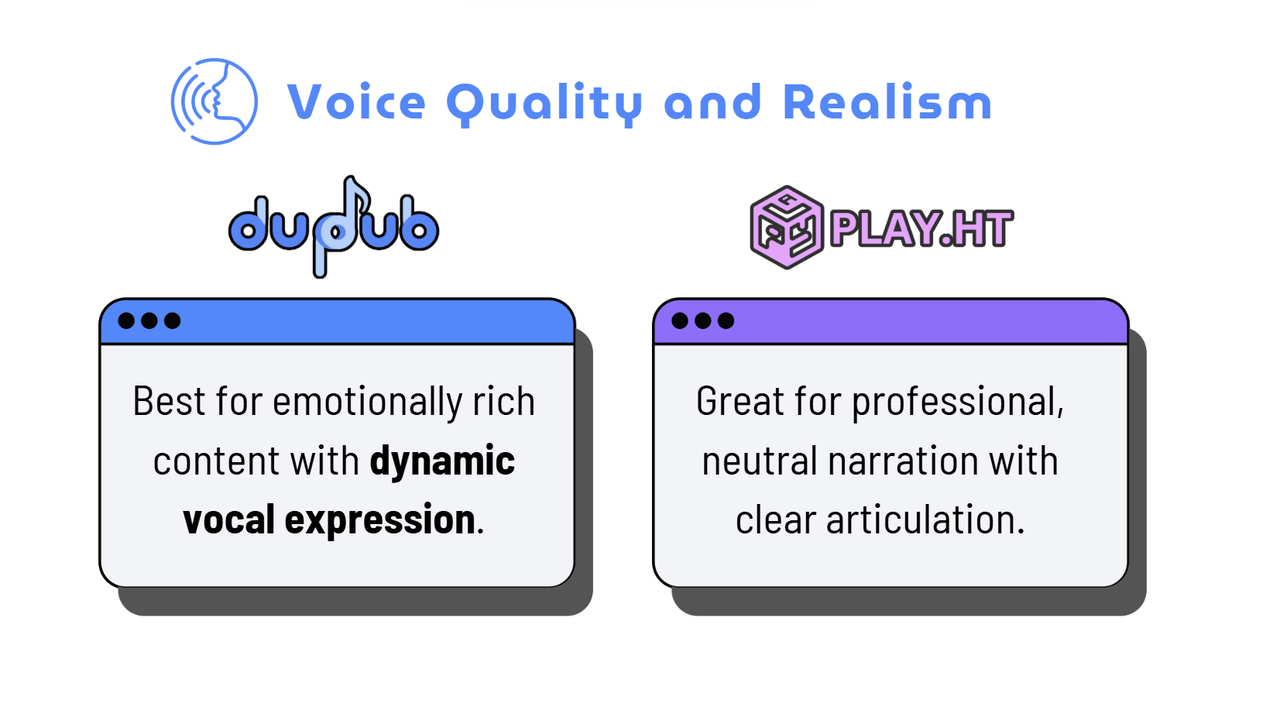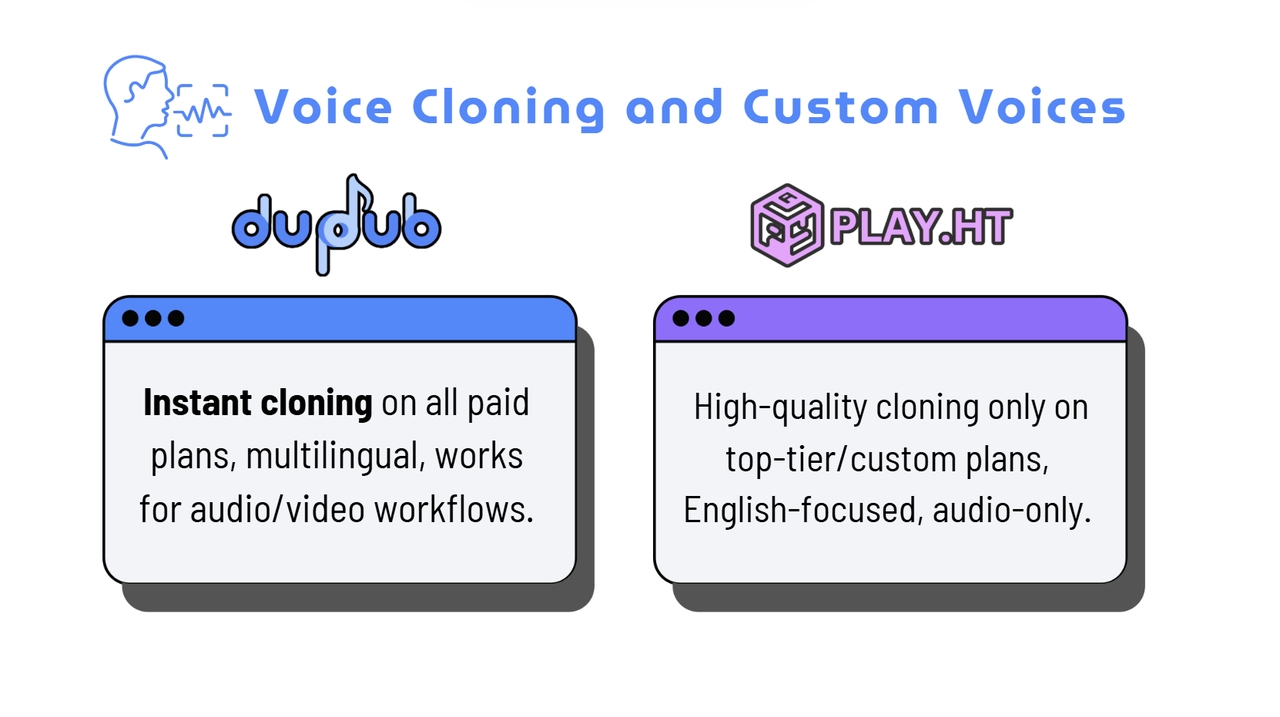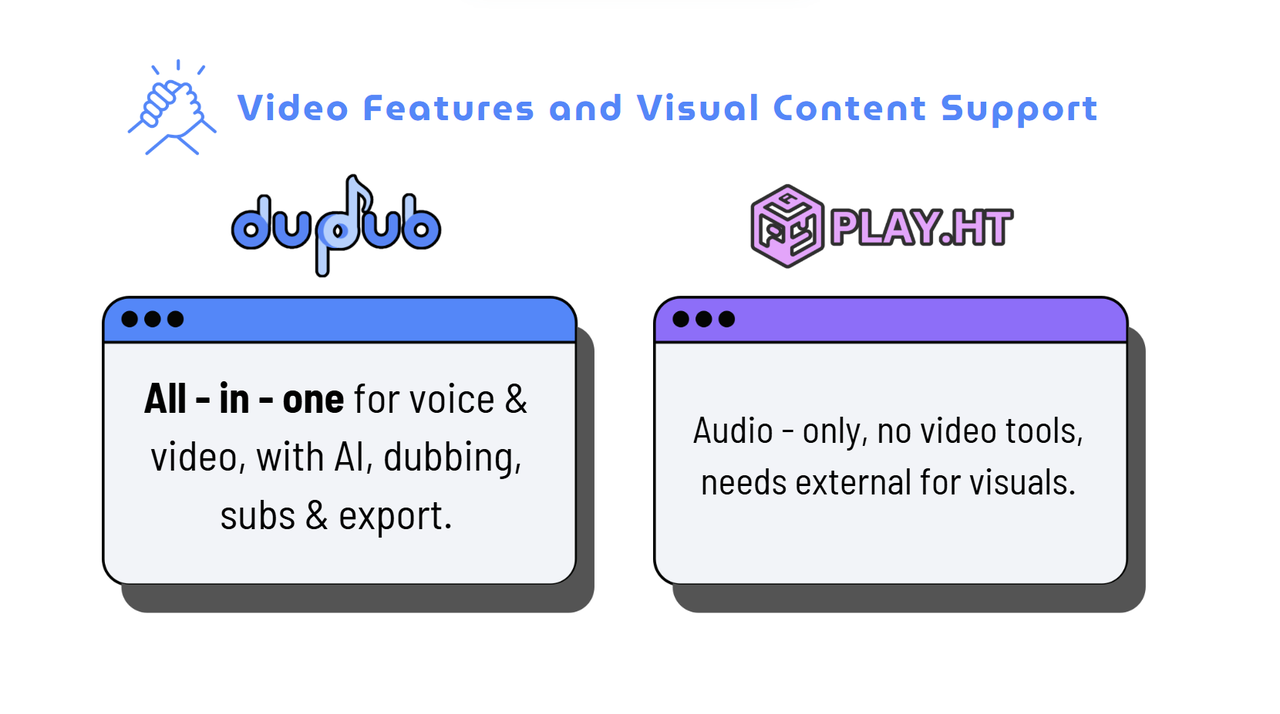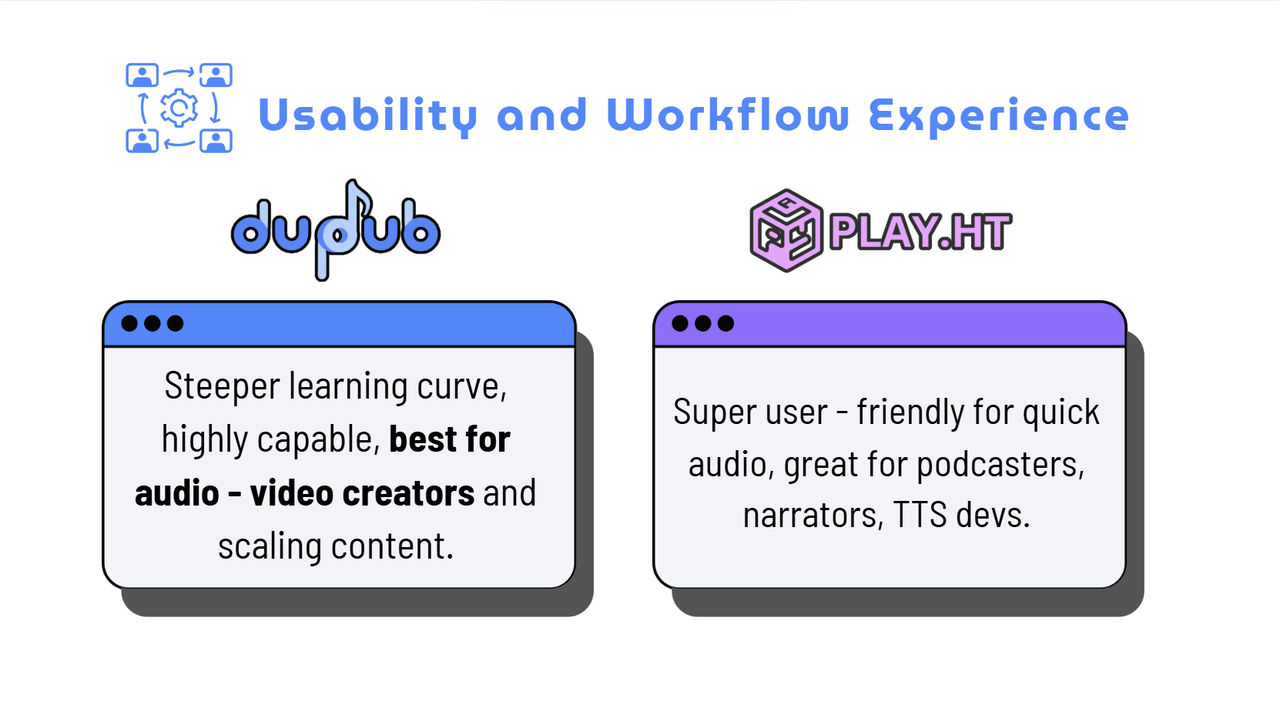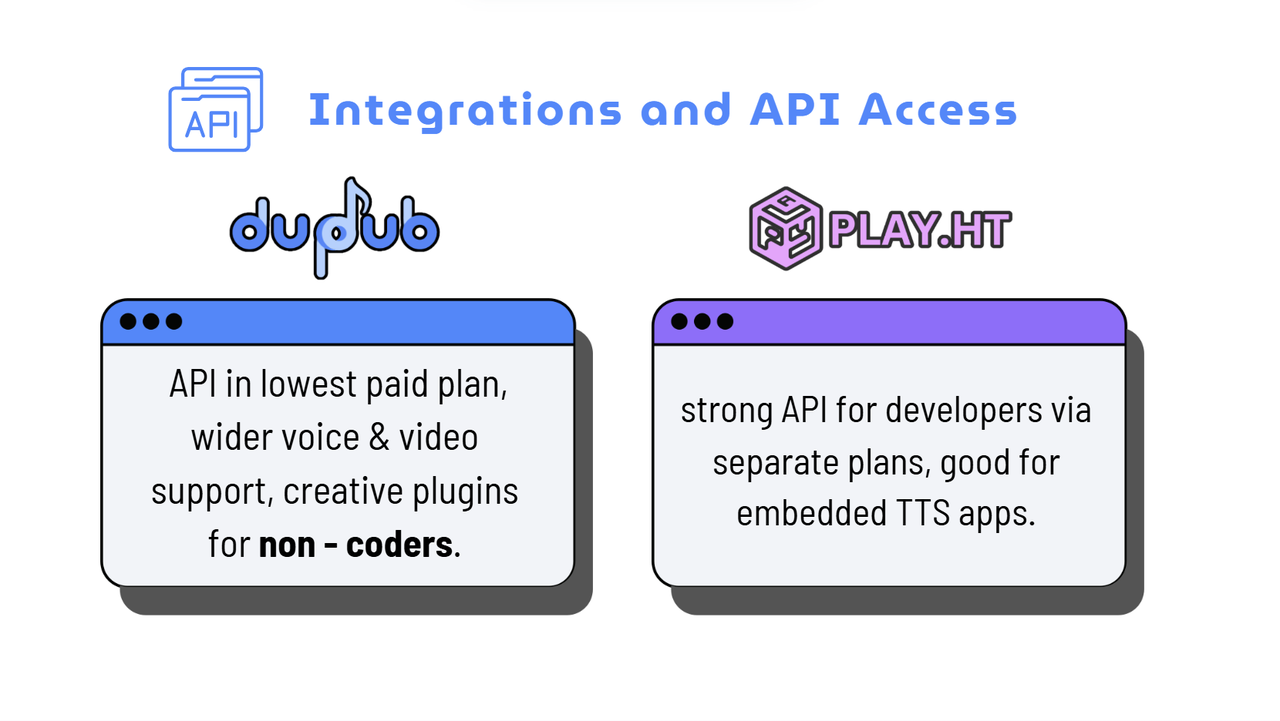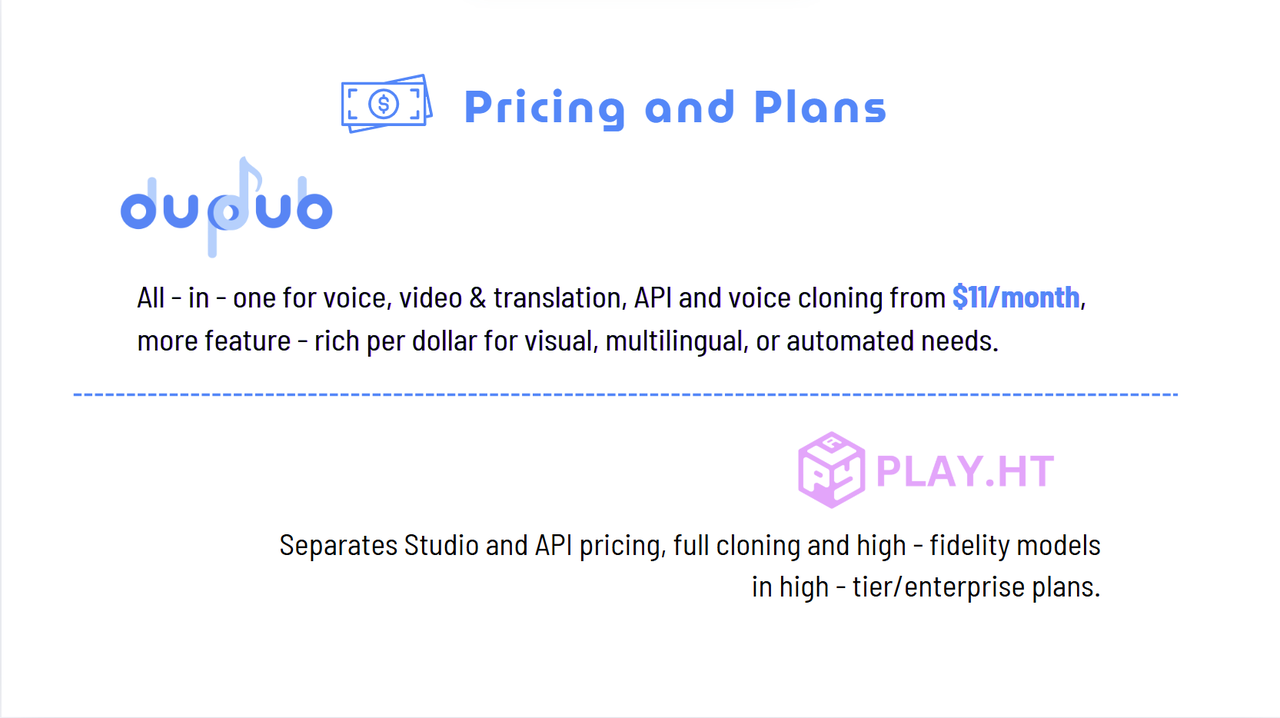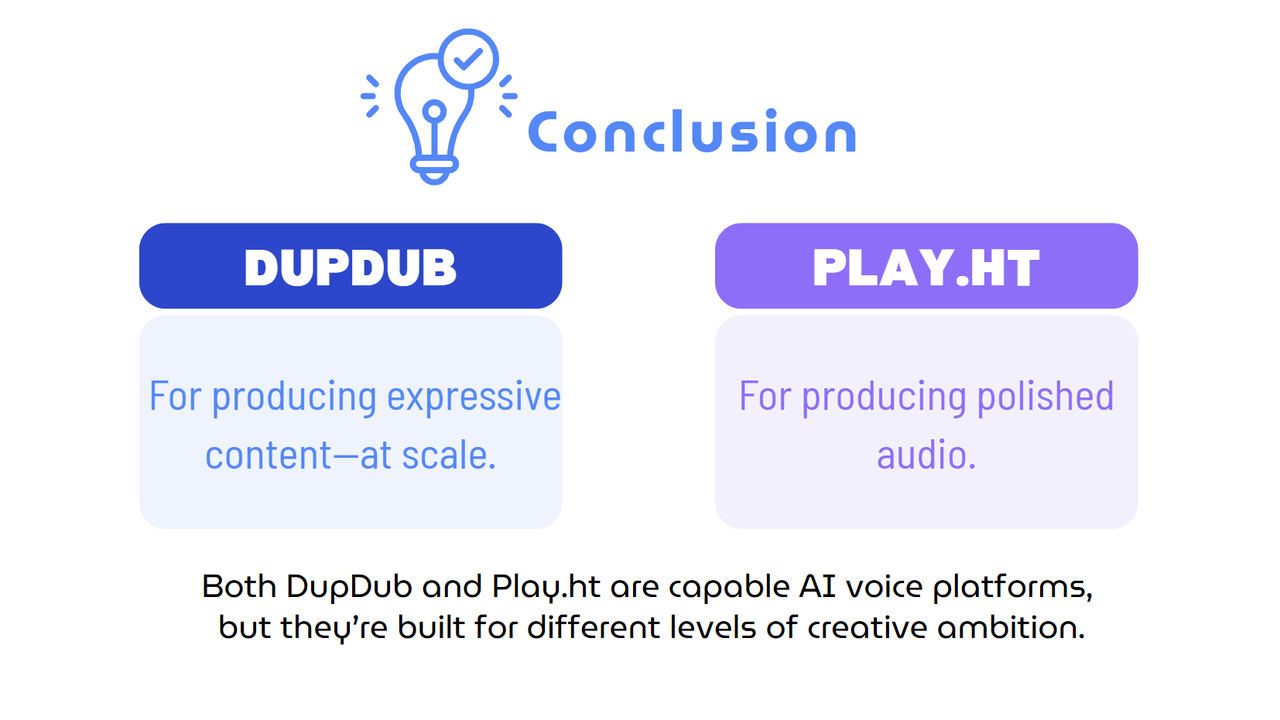In 2025, AI voice generation has evolved far beyond basic text-to-speech. Two leading players—DupDub and Play.ht—are pushing the boundaries for creators who need high-quality voices, multilingual output, and scalable production workflows.
Play.ht has earned attention for its wide voice selection, podcast-friendly interface, and developer APIs. DupDub, on the other hand, offers an integrated voice and video creation suite with advanced features like emotional speech, instant voice cloning, and talking avatars.
This article compares the two across key dimensions—voice quality, cloning, languages, video tools, pricing, and more—to help you decide which platform suits your needs in 2025.
Quick Comparison Table: DupDub vs Play.ht
| Aspect |
DupDub |
Play.ht |
| Voice Quality |
Expressive, emotional, natural |
Clear, neutral, professional |
| Language Support |
47 languages |
40+ languages |
| Voice Library |
700+ voices with 1000+ styles |
800+ voices (standard + realistic) |
| Voice Cloning |
Yes (instant, multilingual, all paid plans) |
Yes (Studio: Unlimited & Enterprise only; API: Business only) |
| Video Features |
Yes – avatars, dubbing, lip-sync |
No |
| Free Tier |
3-day Pro trial (10 credits) |
Free plan – 1000 characters/month |
| Paid Plans & Pricing |
Personal: $11/mo (2 hrs)
Professional: $30/mo (~7 hrs)
Ultimate: $110/mo (~34 hrs) |
Creator: ~$31/mo (~4.5 hrs)
Unlimited: $49/mo
(API billed separately) |
| API Access |
Yes(from Personal Plan) |
Yes (separate from Studio plans) |
| Best For |
Multilingual, video-integrated creative workflows |
Audio-first tasks, podcasting, developer TTS use |
Voice Quality and Realism
When it comes to audio realism, both DupDub and Play.ht offer high-performing voice synthesis—but they emphasize different qualities.
Play.ht is known for clarity and consistency. Its ultra-realistic voices, especially in English, are designed for smooth pacing and accurate pronunciation. These voices excel in formal settings like business narrations, explainer videos, and instructional content. However, the emotional tone of Play.ht voices tends to be flat or neutral, with fewer options for creative nuance.
DupDub, by contrast, focuses on expressive delivery. Its voices can convey joy, anger, sadness, or excitement, giving creators more control over the emotional tone of content. The output feels more “alive,” making it ideal for storytelling, dialogue-driven scripts, or personality-rich branding.
In direct comparisons, Play.ht’s voices are polished and precise, but DupDub’s voices feel more adaptable and human, especially when the emotional context matters.
Summary:
-
Play.ht: Great for professional, neutral narration with clear articulation.
-
DupDub: Best for emotionally rich content with dynamic vocal expression.
Language and Voice Variety
The range of available languages and voice types greatly affects how adaptable a platform is—especially for creators producing content across global markets.
Play.ht supports 40+ languages and offers more than 800+ voices, including both standard and ultra-realistic models. While this makes it one of the largest voice libraries by count, the depth of expressive variation per language—especially outside English—can be limited. Most regional languages offer only a few voice options, often with neutral delivery and minimal stylistic differentiation.
DupDub, on the other hand, provides 700+ curated voices across 90+ languages and accents, with over 1,000 emotional styles. Instead of focusing solely on volume, DupDub emphasizes coverage and emotional versatility. Many supported languages come with multiple voices that vary by gender and tone, offering more flexibility when crafting content in different cultural contexts.
While not every language has the same level of expressiveness, DupDub consistently delivers more stylistic options per language—which is especially valuable for creators who produce content in multiple markets and require tonal coherence across languages.
Summary:
-
Play.ht: Large overall voice count, but limited diversity in non-English languages.
-
DupDub: Broader language and accent support with more expressive variety across regions—ideal for multilingual and cross-cultural projects.
Voice Cloning and Custom Voices
Voice cloning has become a key differentiator in AI voice tools—allowing creators to generate custom voices or replicate their own for brand identity, storytelling, or scalable voice production.
DupDub offers instant voice cloning across multiple pricing tiers. Even the Personal plan (starting at $11/month) includes up to 3 cloned voices, which can be generated in minutes. These voices support multilingual output—a cloned English voice can speak Spanish, Arabic, or Mandarin while preserving vocal tone and identity. This makes DupDub especially useful for personal branding, YouTube creators, or multilingual campaigns using a consistent voice persona.
Play.ht, in contrast, restricts voice cloning to its Unlimited and Enterprise Studio plans, and the Business API plan. These are high-end or custom-priced tiers, not accessible to most entry-level users. While Play.ht’s voice cloning technology can achieve high realism (especially in English), it’s not available on Creator or Developer plans, which limits its accessibility for individual creators or small teams.
Another key difference is use case flexibility. DupDub’s cloned voices are easily used across its broader toolkit—including dubbing, translation, and avatar video workflows. Play.ht’s cloned voices are more tightly integrated with static audio generation.
Summary:
-
DupDub: Instant cloning included on all paid plans; multilingual output; easy to use in both audio and video workflows.
-
Play.ht: High-quality cloning available, but limited to top-tier or custom plans; English-focused; audio-only use.
Video Features and Visual Content Support
In 2025, voice generation is no longer just about audio—many creators need end-to-end solutions that integrate voice with visual content, especially for platforms like YouTube, TikTok, and online learning.
DupDub distinguishes itself as an all-in-one voice and video platform. In addition to voiceover generation, it offers:
-
AI Talking Photo (Avatar): Turn a static image into a speaking video using AI-powered lip sync.
-
Video Dubbing: Translate and replace audio in existing videos while syncing the dubbed voice with the speaker’s lip movement.
-
Subtitle generation and timing: Automatically create multilingual subtitles, matching the generated voice or video.
-
Export as video: Final output can be exported as a video file with voice, visuals, and captions—all done within the platform.
These features streamline multimedia workflows, making DupDub a powerful tool for marketers, educators, and influencers who want to localize or scale content creation without switching tools.
Play.ht, in contrast, is designed purely for audio-first workflows. It does not offer video dubbing, avatar generation, or integrated subtitle tools. Users must rely on external software to align generated voices with visual content. While its voices can be embedded in videos manually, the platform itself does not assist with visual synchronization or export.
Summary:
-
DupDub: Full support for video-based creation—avatars, dubbing, lip-sync, subtitles—ideal for creators integrating voice into video content.
-
Play.ht: Audio-only focus—powerful for narration and TTS, but requires third-party tools for any visual integration.
Usability and Workflow Experience
An AI voice platform is only as powerful as it is usable. When choosing a tool, creators consider not just the output quality but also the ease of navigating the interface, managing projects, and completing tasks efficiently.
Play.ht offers a streamlined, audio-first interface. Its Studio workspace allows users to input text, choose voices, preview samples, and export audio with minimal clicks. The platform feels clean and fast—ideal for users who want quick results or prefer a lightweight tool for podcast narration or blog reading. API users benefit from detailed documentation, and developers find it relatively easy to integrate into apps or pipelines.
DupDub, while broader in scope, manages complexity through a well-structured interface. The dashboard organizes its features—voiceover, video dubbing, avatars, subtitles—into clearly separated modules. Built-in step-by-step flows guide users through complex tasks like multilingual video dubbing or AI avatar creation. While it may take a few extra minutes to learn compared to Play.ht, this structure enables deeper functionality without overwhelming new users.
Where DupDub shines is in its ability to combine tools into a single workflow: translate a script, generate a voiceover, apply it to an avatar or existing video, add subtitles, and export—all within one environment. This level of integration significantly reduces tool-switching and editing time.
Summary:
-
Play.ht: Extremely user-friendly for quick audio tasks; ideal for podcasters, narrators, or TTS developers.
-
DupDub: Slightly steeper learning curve but much more capable; ideal for creators handling audio-video projects or scaling content production.
Integrations and API Access
For developers and automation-focused creators, robust API and third-party integrations are essential.
Play.ht provides a well-documented API, widely used by SaaS platforms and developers embedding TTS into their apps. It supports SSML, multiple languages, and voice selection. However, API access is only available under separate API pricing plans—starting at $9/month for developers. Studio plan users must subscribe separately to use it programmatically, which may add friction for hybrid use cases.
DupDub, by contrast, offers API access starting from the entry-level Personal plan ($11/month). This makes it easier for individual creators or small teams to build voice automation into their workflows without needing a second subscription. DupDub’s API supports not only voice generation but also transcription, translation, and even video dubbing and avatar rendering, enabling end-to-end pipeline integration for complex multimedia use cases.
Additionally, DupDub integrates directly with tools like Canva and ChatGPT, letting non-technical users bring voice AI into existing creative platforms without writing code—something Play.ht currently lacks.
Summary:
-
Play.ht: Strong API for developers, but only through separate plans; great for embedded TTS applications.
-
DupDub: API included even in the lowest paid plan; supports a wider range of voice and video features, with creative plugins for non-coders.
Pricing and Plans
While both DupDub and Play.ht offer scalable pricing, their models differ in structure and accessibility. DupDub uses a credit-based system, whereas Play.ht charges by character count. Feature availability also varies significantly across tiers.
DupDub Plans (Unified platform)
| Plan |
Price |
Voice Time |
Key Features |
| Personal |
$11/month |
~2 hours |
3 voice clones, video dubbing, avatars, API access |
| Professional |
$30/month |
~7 hours |
Faster processing, more clones, extended limits |
| Ultimate |
$110/month |
~34 hours |
High-volume usage, premium support |
Credits can be used flexibly across voice, video, translation, and dubbing. All plans support commercial use.
Play.ht – Studio Plans (for creators)
| Plan |
Price |
Characters/month |
Cloning |
Notes |
| Creator |
$39/month |
250,000 (~4 hours) |
Not included |
Entry-level; no advanced features |
| Unlimited |
$99/month |
Unlimited |
✅ Included |
Voice cloning available |
| Enterprise |
Custom |
Custom |
✅ Included |
Tailored support, security, SLA |
Play.ht – API Plans (for developers)
| Plan |
Price |
Characters/month |
Instant Clones |
High-Fidelity Cloning |
Notes |
| Hacker |
$5/month |
25,000 |
10 |
❌ |
Commercial use allowed |
| Pro |
$49/month |
500,000 |
100 |
❌ |
Standard rate limits |
| Startup |
$299/month |
5 million |
750 |
❌ |
Higher rate limits |
| Growth |
$999/month |
20 million |
Unlimited |
❌ |
Guaranteed latency (400ms) |
| Business |
Custom |
Custom |
Unlimited |
✅ Available |
High-fidelity cloning, SSO, SLA, enterprise |
Summary
-
DupDub provides a single, all-in-one platform for voice, video, and translation workflows—with API and voice cloning available even at $11/month.
-
Play.ht splits pricing into Studio (UI use) and API (developer use), with full cloning and high-fidelity models gated behind high-tier or enterprise pricing.
-
DupDub offers more features per dollar, especially for creators needing visual content, multilingual output, or voice-driven automation.
Pros and Cons Summary
DupDub – Pros
-
Supports 90+ languages and accents for global reach.
-
700+ voices with 1000+ emotional styles for nuanced expression.
-
Voice cloning available from entry-level ($11/mo).
-
Integrated video dubbing, avatar animation, and subtitle tools.
-
Unified API access from all paid tiers.
-
Credit-based model supports cross-feature flexibility.
-
Competitive pricing for high-volume, multimedia workflows.
DupDub – Cons
-
Credit system may be less intuitive for new users.
-
Slight learning curve due to broader feature set.
-
No permanent free plan—only a 3-day trial.
Play.ht – Pros
-
Character-based billing is straightforward for TTS-heavy users.
-
High-quality English and multilingual voices, including ultra-realistic options.
-
Well-documented API with real-time streaming support.
-
Clean, fast UI—ideal for quick voice generation tasks.
-
Podcasting and narration-ready output formats.
Play.ht – Cons
-
Voice cloning only in high-tier or enterprise plans.
-
No video, dubbing, or visual features—audio only.
-
Studio and API are billed separately, complicating hybrid use.
Conclusion:
-
Choose DupDub if your work involves multilingual content, video, avatars, or expressive storytelling—it’s a true multimedia creation suite.
-
Choose Play.ht if you need high-quality audio only, especially for simple, developer-integrated, or English-first use cases.
Use Case Recommendations
✅ Choose DupDub if you want more than just voice.
DupDub is designed for creators who don’t just need audio—but need a production pipeline. Choose DupDub if:
-
You’re creating video-based content (e.g., YouTube, TikTok, e-learning) and need built-in video dubbing, avatars, and subtitles.
-
You work in multiple languages or need to serve a global audience—DupDub supports 90+ languages with regional accents.
-
You want expressive storytelling, emotional tones, or character-driven content—DupDub has 1000+ styles to convey emotion, mood, and intention.
-
You want voice cloning without enterprise pricing—available from just $11/month, with multilingual support.
-
You prefer a centralized platform—generate, translate, dub, and export in one place without tool-switching.
-
You’re scaling content or automating workflows—API access is included in all plans, not gated behind costly tiers.
DupDub isn’t just a tool—it’s a content creation system, ideal for educators, marketers, product teams, agencies, and multilingual video creators.
✅ Choose Play.ht if you only need high-quality voiceovers.
Play.ht is best for:
-
Creators who need audio-only workflows like narration, podcasts, or blog voiceovers.
-
Developers embedding voice into apps and preferring character-based usage tracking.
-
Projects that require neutral, broadcast-ready voices, especially in English.
-
Teams who don’t need video, avatars, or cross-modal features.
It’s a great voice rendering engine, but lacks the broader toolkit of DupDub.
Bottom Line:
If you’re building audio content, Play.ht works well. If you’re building content-driven experiences—with sound, emotion, language, and visuals—DupDub gives you far more power, flexibility, and return on investment.
Conclusion
Both DupDub and Play.ht are capable AI voice platforms, but they’re built for different levels of creative ambition.
Play.ht is an excellent choice if your needs are strictly audio-focused. Its voice quality is clean, its pricing is predictable, and its developer-friendly API makes it easy to embed text-to-speech into digital products. For podcasts, narration, or lightweight voiceover work, it’s a solid solution.
But if you’re building multilingual, multi-format content, DupDub is the better fit. It offers expressive voiceovers, voice cloning from just $11/month, full video integration (including dubbing and avatars), and a unified workflow that scales with your output. Whether you’re localizing videos, automating voice workflows, or building high-volume creative pipelines, DupDub delivers more tools per dollar—and more flexibility per project.
In short:
FAQs
-
Q1: Which platform is better for video content creation?
A: DupDub is the clear winner. It supports AI avatars, video dubbing, lip-sync, and subtitles—fully integrated into the voice workflow. Play.ht is audio-only and requires third-party tools for video.
-
Q2: Can I clone my voice on both platforms?
A: Yes, but with major differences. DupDub allows instant voice cloning starting at $11/month, including multilingual output. Play.ht offers cloning only on higher-tier plans (Studio Unlimited, API Business), and high-fidelity cloning is exclusive to enterprise users.
-
Q3: Which tool offers a more integrated content creation experience?
A: DupDub combines voiceover, video dubbing, translation, and subtitle tools in one platform—ideal for end-to-end content workflows. Play.ht focuses on voice-only generation and requires other tools to complete video or localization projects.
-
Q4: Do both platforms offer commercial usage rights?
A: Yes. Both DupDub and Play.ht allow commercial use on all paid plans. Play.ht’s free tier also allows commercial use (with limits), while DupDub’s 3-day trial is for evaluation only.
